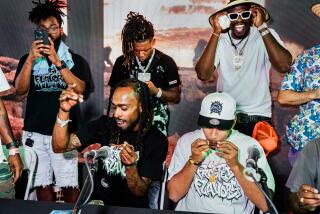Art Fair Draws a Healthy Response : Despite Some Growing Pains, Attendance Almost Doubles
With a percussive “pop!” Hans Mayer uncorked a bottle of Moet Chandon champagne Monday night as the 2nd International Contemporary Art Fair came to a close and the art dealer from Germany gloated over his healthy sales figures.
Moments later, fair coordinator Brian Angel, bleary-eyed with exhaustion, pried opened a warm can of Coke. But Angel had reason to celebrate too. The five-day fair, while still suffering growing pains, drew a crowd almost twice the size of its initial outing, and is scheduled to be staged again--the ultimate measure of success.
About 26,000 people visited the fair, held at the Los Angeles Convention Center last Thursday through Monday. They surveyed about 5,500 fine artworks by 1,200 contemporary and modern artists from 170 galleries (40 more than last year) from some 21 countries around the world. Last year, the event attracted about 14,600 viewers.
“I think it’s remarkable, by any standards, to almost double attendance at only the second appearance,” Angel said. “This augurs well for the galleries that took part in the fair, and indeed for the Los Angeles arts community.” He said that the next fair will be held sometime in December next year.
The overall success of the fair was particularly critical, as it determines the future viability of the event, Angel said. Fair organizers were also under pressure this time around to improve upon last year’s fair, which, for a variety of reasons, didn’t attract the publicity, people or purchases hoped for.
The quality of the art this year, which ranged from a small $90 lithograph to an inseparable suite of 18 large-scale abstract paintings for $2 million (which hadn’t sold by nearly closing time Monday night) was very high, according to prominent dealers, collectors and museum officials.
However, sales totals, critical in rating the fair’s success, were practically impossible to come by Monday night. During a quick survey, only two dealers out of about 15 would divulge dollar figures: Patricia Asher, co-owner of the local Asher/Faure Gallery, said that she will have made about $160,000 after some works placed on hold are sold, and Raimond Thomas, owner of the Galerie Thomas in Munich, said the pieces he sold fetched about $200,000.
A pattern that emerged last year seemed to have repeated itself, however. On the whole, Los Angeles dealers with established clientele rang up more sales than out-of-town gallery representatives, especially those from Europe. And these dealers are an essential factor in providing a base for an international fair--which many art community leaders agree is a valuable asset to the vitality of the local art scene.
“We did as well, if not better than we expected,” reported Marti Koplin, owner of the Koplin Gallery in West Hollywood. “And the exposure has been wonderful. We’ve had interest from dealers and curators in Chicago, New York and Seattle. There’s no other way, beside a fair, that we can get that kind of exposure.”
Some local dealers who attended last year’s fair did not return this year. But most interviewed on Monday said they would be back in 1988.
However, Jill George, owner of the Thumb Gallery of London, said she was “very disappointed” in her sales and would not return next year, because “we can’t afford it.” It cost the Thumb Gallery $30,000, including shipping fees and booth rental, to take part in the event, George noted.
Eva Poll, owner of a gallery in Berlin that bears her name, was also dissatisfied. Though she said she may return in 1988, she repeated her own complaint made last year and shared by some other European dealers: “People in Los Angeles are very much uneducated about European art. They don’t dare to buy (a work) because they know nothing about the artist, even if they like it.”
And, indeed, not everyone liked all the European art at the fair, modeled after similar events in such cities as Cologne, Basil and Chicago. One woman walked past a group of surrealist paintings from Paris and groaned “This is horrible; it’s awful” as she surveyed a display of headless and limbless victims.
Such reactions didn’t worry Angel, even though he said that about $1.5 million was spent to put on the event. (“Lighting alone cost $200,000.”)
“This is a symptom of new fairs which will be overcome,” said Angel, who works for Andry Montgomery, a London firm that produces cultural and trade events. “Familiarity is the key note in selling and buying successes. Local galleries seem to have done well and indeed very well in many instances. But Europeans seem to have done well enough to encourage them to return.”
While Angel didn’t know the total number of galleries, foreign or American, returning next year, he named about 18 foreign dealers who have already requested space for the 1988 show, and claimed that the fair has now “secured a firm basis for a continuing annual quality event.”
In addition, there were several satisfied European dealers, such as Hans Mayer, who owns a gallery in Dusseldorf.
“Our sales were very nice, very good,” said Mayer, a 21-year veteran of art fairs elsewhere around the world. “Last year we did quite well and we will be back next time for sure. The fair has improved very well in its organization, attendance and sales since last year, and it’s only the second time around. Usually it takes many years to achieve this level.”
Still, Angel said that fair organizers will continue to work with local museums and art institutions to familiarize the local community with foreign art and “to strengthen both the knowledge of the fair and the buying base.”
More to Read
The biggest entertainment stories
Get our big stories about Hollywood, film, television, music, arts, culture and more right in your inbox as soon as they publish.
You may occasionally receive promotional content from the Los Angeles Times.










